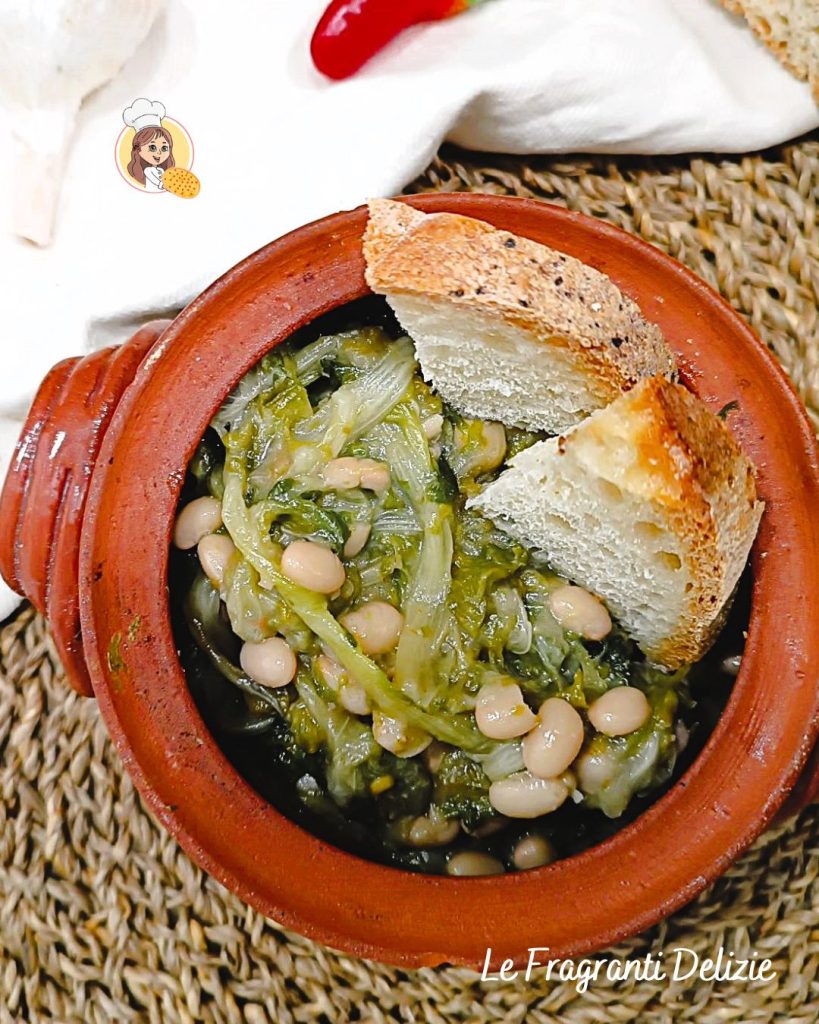The Bean and Escarole Soup, or ‘pignato magro,’ is a simple and healthy dish from traditional Campanian cuisine made with beans and escarole. Originally, it was a poor farmer’s dish, nowadays it is a comfort food typical of the winter months on our tables.
I remember as a child, when mom prepared these dishes, and it happened often, for me it was a drama. Today instead, it might seem absurd, preparing and eating simple and genuine dishes sweetly takes me back many years, accompanied by tender smiles. Yes, because with my father it was a struggle when I didn’t eat what was on the table. A struggle I almost always lost. The dish, left untouched, was taken and put in the pantry or the oven accompanied by my father’s usual phrase “You will eat it when you are hungry”. This meant that in the evening it was served to me again and alas I had to eat it.
If I could go back, I would eat it, just to make my dear dad, who is no longer here, happy, and to satisfy my mom, who at the venerable age of eighty-five is still an excellent cook.
But enough chatter, soon to the stove to prepare your fragrant delights 👩🍳 and please, let me know in the comments how they turned out for you 😉
Oh, I almost forgot… Follow me and you won’t regret it, word of Silvana!
To follow me on Facebook click HERE, on Instagram HERE and you won’t miss any recipe. Return to the HOME PAGE
You can also read:

- Difficulty: Very easy
- Cost: Economical
- Preparation time: 20 Minutes
- Portions: 4
- Cooking methods: Stove, Slow cooking
- Cuisine: Italian
- Seasonality: Autumn, Winter and Spring, All seasons
Ingredients for Bean and Escarole Soup
To prepare the bean and escarole soup you will need:
- 1 head escarole (large)
- 25 oz white beans (cannellini) (pre-cooked)
- 2 cloves garlic
- to taste extra virgin olive oil
- 1 chili pepper (optional)
- to taste salt
Preparation of Bean and Escarole Soup
To prepare the bean and escarole soup, you can choose to use dried beans or canned pre-cooked ones. I, despite working, love dried ones. It will definitely take much more time, but I assure you that you will gain in flavor. If you decide to use dried ones, you must soak the beans after rinsing them well, for 12 hours; in this case, I recommend doing this the night before. After this time, rinse the beans and cook them by bringing to a boil. Then, cook them slowly, lowering the temperature and letting them simmer, removing the foam that will form on the surface. Once cooked, it will take about 2 and a half hours, set them aside and focus on the escarole.
If you decide to use pre-cooked beans, then the task is easier. You can start preparing the soup by skipping this step and move directly to cleaning and cooking the escarole.Wash the escarole thoroughly, remove the central stem and the outer leaves and any that are damaged.
Boil it in a pot with a little water and lightly salted, cover with a lid and cook for about 10 minutes, just enough time to soften. Then drain it, keeping some cooking water aside.In a large pan heat the extra virgin olive oil with two peeled garlic cloves and then add the beans you have previously cooked with a bit of their cooking water and season with the chili pepper, salt, and cook for 5 minutes over medium heat.
Add the escarole to the beans and cook gently, stirring the soup occasionally. Add some vegetable cooking water if necessary. The soup will be ready when the vegetables and beans are well combined.
Add a drizzle of extra virgin olive oil and serve the bean and escarole soup piping hot, accompanied by toasted bread slices.
Storage, tips
The bean and escarole soup can be stored in the fridge for a few days, in an airtight container.
The soup is also great for topping delicious bruschettas.

